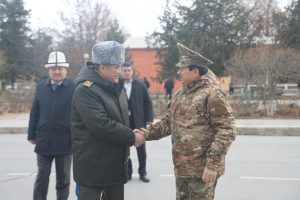Kyrgyz and Tajik officials said this week that more than 90 percent of their mutual border has been agreed upon. Kyrgyz President Sadyr Japarov is hopeful for a full resolution by the spring. It’s big news for a border that has been among the most difficult in the region, flaring into deadly violence in 2021 and 2022.
Despite occasional sharp remarks, the two sides have pursued a consistent calendar of negotiations that began yielding results in October, with the signing of the mysterious “Protocol No. 44.” The contents of the protocol remained secret, but it was cast as a critical pathway forward. “We will soon make a final decision on defining state borders,” Kyrgyzstan’s State Committee for National Security chief Kamchybek Tashiev said at the time.
This week Tashiev and his Tajik counterpart, Saimumin Yatimov, had similarly rosy words to offer following negotiations in Batken.
As reported by Asia Plus, a Tajik news outlet, on December 13 Yatimov remarked, “Quite a huge amount of work has been done today, we have advanced more than 120 km, and we have agreed on these issues in principle. If we take the total length of the state border… [we] can confirm that more than 90 percent of the state border has already been described.”
The Kyrgyz-Tajik border is about 975 kilometers long (sometimes it is reported as 972 km, sometimes 980 km). As of 2020, according to an RFE/RL report, 519 km of the border had been defined; Kloop cites a 2022 figure of 664 km having been agreed upon. That would leave around 300 km to go, give or take a few dozen, as of the start of the year.
In recent weeks as negotiations have alternated between Tajikistan and Kyrgyzstan, the two sides have announced agreements on 24.01 km (on December 5) and 47.05 km (on December 14). Some details have been offered about the areas discussed, but the two sides have not yet provided a full accounting of what areas have been settled and specifically how.
In his statement alongside Yatimov on December 13, Tashiev said, “At the moment we have almost completed all controversial issues [on the border]. There are only a few meetings left to finally finalize the issue with the state border.”
Asia Plus concluded an article about the progress with a dash of reality: “Negotiations on delimitation have been ongoing since December 2002. The failure to resolve this issue has repeatedly become the cause of conflicts involving local residents and military personnel of the two republics, including with the use of firearms.”
The border has been a source of tension for three decades, culminating in the violence in September 2022 amid which researchers say both sides may have committed war crimes in targeting civilians. If Bishkek and Dushanbe can, indeed, agree to the entirety of their border, it will be a moment of triumph. That said, agreeing on paper maps is one step in a longer process that will be vastly more difficult. As the Kyrgyz and Tajik governments move forward, they’ll need to do considerable work with the publics that have long lived in these contested space — they are the ones who have to live with whatever border the government have decided on.

































